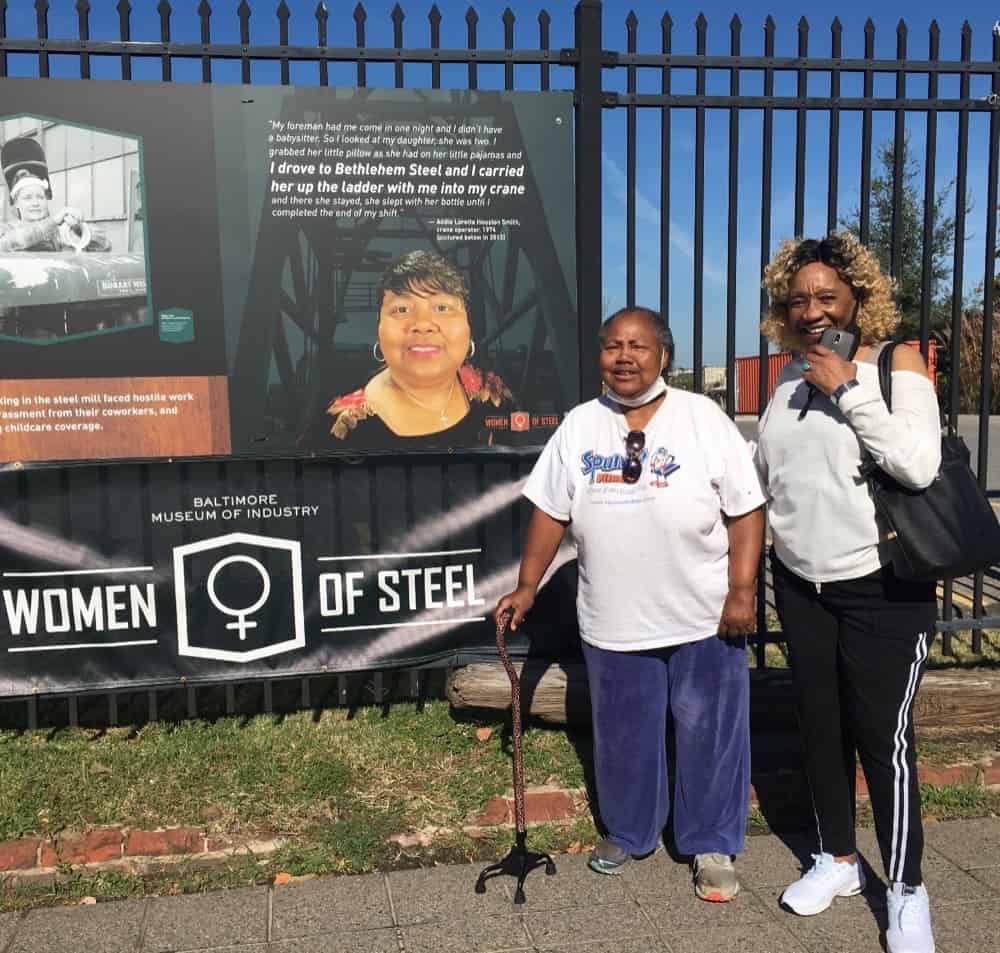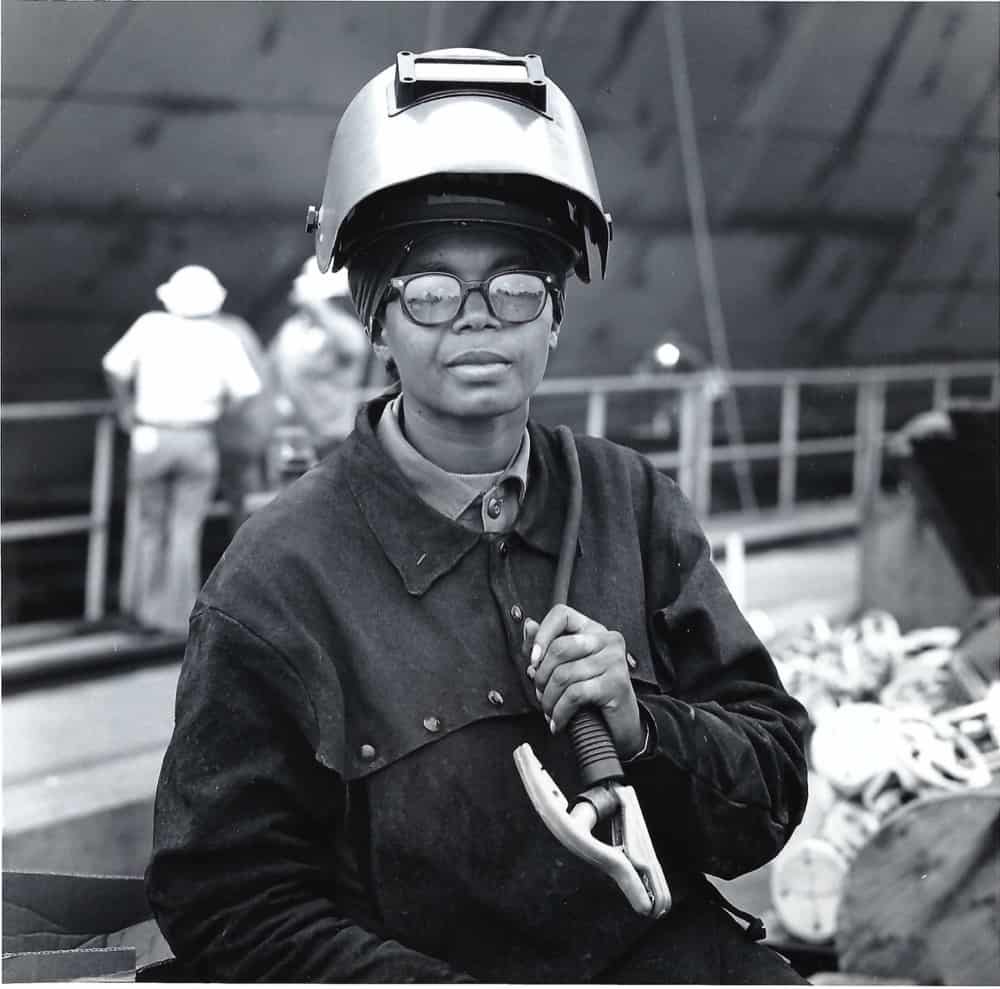A Baltimore museum celebrates the women who built America
She was part of Black America’s Great Migration, destination (though she didn’t know it at the time) Sparrows Point.
When a teenage Alberta Buckson made her way to Baltimore from Chester, South Carolina in the 1950s, she had a strong desire to work but not much education. “I took jobs as a domestic back home and in Baltimore,” said Buckson, now 84. “I cleaned houses and looked after other people’s children.”
For that, she said, the pay was about eight dollars a week. Then, after years of struggle, she saw a notice in a local paper to learn a trade and trained as a welder. To Buckson’s surprise, she was a natural with an acetylene torch and landed a good union job at the Bethlehem Steel shipyard on the Patapsco River.
Except for the occasional strike or lay-off (during which she was able to find welding work on the side), the longtime West Baltimore resident never had to worry about feeding her family again.
“Believe it or not, I loved it,” said Buckson, who was intimidated—but not for long—upon glimpsing welders practicing the craft while hanging off the sides of mammoth ships.
“Once the bosses knew I could do the job, they didn’t have no mercy on me,” said Buckson, whose early career included work on five supertankers built by Beth Steel in the 1970s. “They worked me on those ships all the time.”
She now makes ends meet on a shipbuilder’s pension. It’s not what it might have been had Beth Steel not declared bankruptcy in 2001 and final dissolution two years later, but together with Social Security she has some peace of mind each month.
Buckson’s career at what was once the largest steel mill in the world—an expanse of four end-to-end miles and more than 3,000 acres that employed tens of thousands at its height—is one of many now celebrated at the Baltimore Museum of Industry on Key Highway.
The exhibit, mounted outside in deference to the coronavirus pandemic, is called “Women of Steel.”
Devoted exclusively to Buckson and her steelworking sisters—just one of many nationwide salutes to the 100th anniversary of women winning the right to vote via the 19th amendment—it will remain on site through the end of April.
Later this year, perhaps by October, a larger exhibit about all aspects of Bethlehem Steel’s long presence in Baltimore will go up. Depending on the status of the pandemic, it may be constructed inside the museum, or on the waterfront at 1415 Key Highway.
Both exhibits—including protective gear, wooden “shoes” that wouldn’t melt near the ovens, tools, photos, and maps—were made possible with funding and artifacts donated by Tradepoint Atlantic, the logistics, warehouse, and distribution company that purchased the massive Sparrows Point site in 2014.
“Some of the old mill buildings and the administration building were left untouched for years—papers and other personal objects left sitting where people left them the day the mill closed,” said Aaron Tomarchio, the company’s senior vice-president for corporate affairs. “A lot of our preservation work was done just ahead of the demolition cranes.”
As far back as the early 20th century when they were clerical workers, before moving into labor jobs in the 1930s, many thousands of women earned a living “down the Point.”

Addie Smith, a crane operator, was one of them. One day, said a museum official who took down Smith’s story, Addie did not have childcare and had to get to work. So she swaddled her baby in blankets and took the child to work with her—100 feet up a ladder and into the crane on a 12-hour shift.
That should put her in the “take your child to work day” hall of fame.
“We want to educate the community about the work these women did,” said Claire Mullins, marketing director for the BMI. “And what unions look like—the chance for a decent paying job that allowed [workers] to buy a house, solid, well-paying jobs that suddenly evaporated [with the decline of
Beth Steel].”
Blame greed or politics or China, whatever bottom-line boogeyman you like, but those jobs and their accompanying benefits went away slowly and then suddenly; jobs that sustained large sections of Baltimore City and its immediate suburbs for most of the 20th century. The last ship built keel to crow’s nest at Sparrows Point was the U.S.N.S. Tanner, a Navy ocean mapping vessel launched in 1990.
“I did heavy work and had my shoulders operated on three times.” said Mary Jacobs Lorenzo, who worked in the electrical repair department and served as chair on the civil rights committee of the local steelworkers union.
Now 80 and living in Essex, Lorenzo said she “replaced worn-out bearings in the crane shafts. They had to line up within a thousandth of an inch. You had to sort of twist your hand backwards to hold the new bearing and slip it in without dropping it.”
Which took its toll. “After the last surgery, they said if I went back to work it would happen again,” said Lorenzo, who retired in 2001 at age 61, after 31 years of service.
Michelle Marsh, of the Turkey Point Road neighborhood not far from Sparrows Point, joined the rank-and-file in 1995, following her sister into
the mills.
“It was like no other job I had before,” said Marsh, now 56 with more than a half-dozen different positions on her steel resume. “I’ve never witnessed such a lack of respect and such hatred between the employees and the management.”
Marsh initially worked for Bethlehem Steel and then a handful
of companies that took over in its wake—five different owners that
tried and failed to make a go of it in the first decade of the 21st century.
By 2012, the making of steel on the peninsula just outside of Dundalk was gone for good.
“The pride was being able to have a good-paying job making an American product,” said Marsh. “The workers saw each other more than we saw our own families. We became family and I made sure I pulled my weight.
“Even though I was often the only woman [in a particular crew], I didn’t see myself as a female steel worker. I saw myself as a steelworker.”



